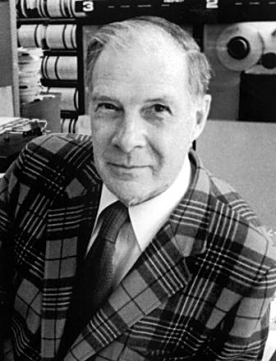[C’est à l’inventeur de la distance de Hamming et des codes correcteurs d’erreurs, Richard Hamming, qu’est aujourd’hui consacré notre article tiré de Ma petite encyclopédie.
Demain il sera question de lettre cadeau]
Richard Hamming
 (Fair Use)
(Fair Use)
Richard Hamming est un mathématicien né en 1915 à Chicago (Illinois) et décédé à Monterey (Californie) en 1998.
On lui doit les codes de Hamming et la distance de Hamming.
Il obtint son doctorat en 1942 à l’Université de l’Illinois et se marie la même année avec Wanda Little.
Il est professeur à l’Université de Louisville lorsqu’éclate la seconde guerre mondiale. Il quitte alors son poste et rejoint le projet Manhattan en 1945 (projet de recherche qui devait aboutir à la construction des premières bombes atomiques américaines). Il est chargé de travailler sur les ordinateurs IBM qui eurent un rôle très important dans le projet. Il fut rejoint par sa femme qui travailla également pour le Projet Manhattan (elle travailla plus tard avec Enrico Fermi)
Dans Mathematics on a Distant Planet publié en 1998, Richard Hamming évoque une phase intéressante (et troublante) de son travail :
…at Los Alamos … we were designing atomic bombs. Shortly before the first field test (you realize that no small scale experiment can be done – either you have a critical mass or you do not), a man asked me to check some arithmetic he had done, and I agreed, thinking to fob it off on some subordinate. When I asked what it was, he said, « It is the probability that the test bomb will ignite the whole atmosphere. » I decided I would check it myself! The next day when he came for the answers I remarked to him, « The arithmetic was apparently correct but I do not know about the formulas for the capture cross sections for oxygen and nitrogen – after all, there could be no experiments at the needed energy levels. » He replied, like a physicist talking to a mathematician, that he wanted me to check the arithmetic not the physics, and left. I said to myself, « What have you done, Hamming, you are involved in risking all of life that is known in the Universe, and you do not know much of an essential part? » I was pacing up and down the corridor when a friend asked me what was bothering me. I told him. His reply was, « Never mind, Hamming, no one will ever blame you ».
De 1946 à 1976, Richard Hamming travaille pour les laboratoires Bell où il collabore avec Claude Shannon.
Il écrit à ce sujet :
[At] Bell Labs I came into a very productive department. Bode was the department head at the time; Shannon was there … I shared an office for a while with Shannon. At the same time he was doing information theory, I was doing coding theory. It is suspicious that the two of us did it at the same place and at the same time – it was in the atmosphere.
Richard Hamming est surtout connu pour ses travaux sur la détection d’erreurs et les codes correcteurs d’erreurs. C’est en avril 1950 qu’il publia son texte le plus important dans ce domaine Error detecting and error correcting codes. Ce texte est à l’origine de concepts qui nous sont aujourd’hui familiers comme les codes de Hamming ou la distance de Hamming.
Pour en savoir plus
Bibliographie
ERDMAN R. C. The application of the Hamming error correcting code to digital data communication systems. [s.l.] : [s.n.], 1963.
HAMMING R. W. Calculus and the computer revolution. Boston : Houghton Mifflin Company, 1968.
HAMMING R. W. Coding and information theory. Englewood Cliffs : Prentice-Hall, 1986. ISBN : 978-0-13-139072-0.
HAMMING R. W. Computers and society. New York, N.Y., [etc. : McGraw-Hill, 1972.
HAMMING R. W. Digital filters. Mineoloa, N.Y. : Dover, 1989. ISBN : 978-0-486-65088-3.
HAMMING R. W. Numerical methods for scientists and engineers. 2nd. edition. New York St. Louis San Francisco : Mc-Graw-Hill book C°, 1973. 721 p.(International series in pure and applied mathematics). ISBN : 978-0-07-025887-7.
HAMMING R. W. The art of probability for scientists and engineers. Redwood City (Calif.) : Addison-Wesley, 1991. 344 p.ISBN : 978-0-201-51058-4.
HAMMING R. W., KAISER J. F., BELL COMMUNICATIONS RESEARCH I. You and your research: seminar by Richard W. Hamming : transcription of the Bell Communication Research Colloquium Seminar « You and your research ». Morristown, NJ : Bell Communications Research, 1986.
